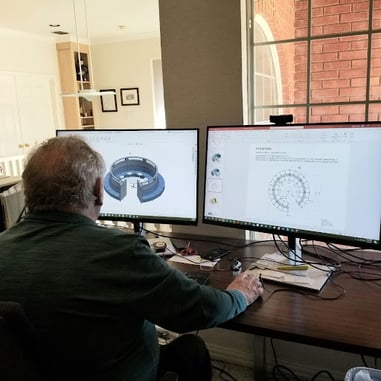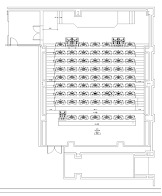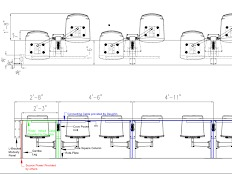Gone are the days of painstakingly drawing up blueprints and the hours of added work required for even minor modifications. Across all aspects of building design and construction, technology is lending us a helping hand, getting us better results, homogenizing the process, and exceeding customer satisfaction to build resilient futures. That technology is BIM (building information modeling). We, at Dauphin Human Design Group, integrate BIM in our daily processes of concept development, and digital modeling and fabrication.
What is BIM?
Designers have been implementing BIM software into their processes for around a decade now. BIM (building information modeling) is a technology that grants you the possibility to plan your project efficiently, identify where problems may arise, and find solutions before construction even begins. This digital model holds all the information about a project and streamlines the whole design and construction process. It is a wise bet in an industry where time is money, but that’s not the only advantage. What else can BIM do for you?
BIM Means Precision to Increase Customer Satisfaction
By now, you may know that BIM programs–such as Autodesk BIM 360 or Revi–offer huge advantages in the design and construction process. A single program that combines the specifications and instructions for the individual components of a design, BIM is a technology that allows all participants working on a project to be on the same page, harmonize the process, and overcome roadblocks to ensure timely completion. BIM provides a digital hub that every participant in a project can access. Every aspect of the design is available at the click of a button, which means that designers, contractors, and end-users can obtain a clearer, more precise understanding of the work at hand. At the time of designing the model in BIM, each party can have a clear understanding of the “what/why/how” of their particular job, allowing for questions to be raised before construction even commences. An extremely precise model gives way to an extremely precise end product.
The benefits are apparent at every level. Client satisfaction is a key performance indicator and the use of innovative technology is undoubtedly an efficient way to raise satisfaction and springboard your company’s image. Clients can go as far as to walk through the digital model of the design and even interact with its features using VR, and this can help manage customer expectations from the outset - saving the company costly adjustments further down the line.
Your company’s reputation can be further enhanced by using BIM long after the design process has ended since the digital copy of the design doubles as an instruction manual for the end-user. Smart building features such as automatic heating, ventilation, lighting, fire protection, and access control can be incorporated, but it is just as important that the client knows how to work these features.
You, as the architect, can access the digital model and offer this information to the client, even if the request is about a feature that is outside your area of expertise - because the BIM document contains every piece of information about all the features of the design. Everything is connected in one, easily accessible, document.
.jpg?width=718&name=architect-holding-digital-tablet-with-building-mod-2021-10-05-14-23-45-utc%20(1).jpg)
BIM Means Time and Money Savings
You now know that BIM can be leveraged to manage customer expectations and improve the level of satisfaction, but it also has numerous advantages during the design process itself. According to the 2020 Jobsite Report, only 28% of contractors finish a project on time and within budget. One of the factors for this is poor coordination between designers, architects, cost analysts, contractors, and clients.
Using BIM revolutionizes coordination. Every participant has access to the design and can modify it and, when one of these modifications affects another element of the design - whether structural or aesthetic - every other aspect of the BIM model is automatically updated. Each participant can access the same model and instantly see how changes affect their role in the project. Coordination and communication become streamlined and this is reflected in the timing of the whole project.
The same Jobsite Report affirms that 69% of contractors blame poor coordination for missing deadlines and going over budget. With $1.3 trillion spent per year by the construction industry in the US alone, it is easy to see why optimum coordination is an essential parameter. Traditional coordination models involve meetings and communication between parties who don’t understand each other’s job - BIM can attenuate this slow, linear progress and allows a project to become multidimensional.
BIM Means Safer Working Environments
Many will shout about the time and cost benefits of using BIM, but a lesser-considered implication is that of health and safety - both during the construction process and for end-users after the project has been completed. Safety has always been a key factor to consider, and with the use of BIM, we can harness the power of technology to detect hazardous aspects and ameliorate them, resulting in safer working environments for all those involved in a project, from designers to end-users.
-1.jfif) Dauphin featured product: Atelier Sofa. The Kering Building, Wayne, New Jersey. Design Firm: HLW
Dauphin featured product: Atelier Sofa. The Kering Building, Wayne, New Jersey. Design Firm: HLW
BIM’s Outstanding Results
The results from using BIM speak for themselves. BIM programs such as Navisworks or Archicad allow us to see the results of our decision-making before carrying out the process itself. Historically, trial-and-error has defined the design and construction process and yielded inconsistent results, the use of BIM means we can foresee the final results before construction begins and make necessary changes in advance. All this translates into solid decision-making and better outcomes.
Dauphin’s Design Services


Dauphin Americas leverages the benefits of industry-standard configurators–such as our Symbol Library, ProjectMatrix, and MyConfigura–to offer clients thoughtfully designed product layouts that can be reconfigured in the future. The ability to reconfigure the products ensures their extended lifespan, both in functionality and high-performance.
We offer a complimentary service that supports expediting your project, from space planning and layouts to site visits and project management, all the way to installation and delivery. The process of designing a high-performing product and lasting solution involves an interactive, continuous, process between Dauphin Americas and the partners involved in the project.Through our multifaceted process, we provide CAD data, BIM files, product drawings, amongst others, to ensure the client has everything they need to succeed.


To get inspired, check out our Fixed Seating projects.
.jpg?width=718&name=unnamed%20(1).jpg) Fixed Seating: Rota Swing-Away. NJIT, New Jersey
Fixed Seating: Rota Swing-Away. NJIT, New Jersey
BIM revolutionizes the design and construction process from start to finish, and beyond. All of the participants in a project have better insight teamed with the ability to detect potential fallbacks, and all this is reflected in the timing of a project, the cost of it, and the customer satisfaction throughout. Because a BIM document is the one-stop solution for all the participants in a construction project, the quality of the work carried out is improved. Everybody knows exactly what to do, when to do it, how to do it, and why they are doing it. Errors and inconsistencies are almost eliminated from the process and this is reflected in the quality of the work carried out. BIM is the beginning of the future in the design world, and it’s time we all embrace its value.
Sources compilation
Dobbs, Richard et al. “Infrastructure productivity: How to save $1 trillion a year.” McKinsey & Company, www.mckinsey.com/business-functions/operations/our-insights/infrastructure-productivity# Jan. 1, 2013. Accessed May 2021.
Ellis, Grace. “100+ Construction Industry Statistics.” Digital Builder, constructionblog.autodesk.com/construction-industry-statistics/ Apr. 18, 2021. Accessed May 2021
Thurairajah, Niraj. “Leveraging Customer Satisfaction Using BIM: House Builders’ Perspective.” Research Gate, www.researchgate.net/publication/343112475_Leveraging_Customer_Satisfaction_Using_BIM_House_Builders'_Perspective May 2016. Accessed May 2021.
Wojslaw, Krzysztof. “Top 12 benefits of BIM technology - Why should I use BIM?” BIM Corner, bimcorner.com/benefits-of-using-bim-technology/ Aug. 11, 2019. Accessed May 2021.
Wolfe, Scott. “2020 Report: Construction Suffers From Wasted Time & Slow Payment.” Levelset, www.levelset.com/blog/2020-report-construction-wasted-time-slow-payment/ Apr. 30, 2020. Accessed May 2021.
“Why BIM matters.” Chapman Taylor, www.chapmantaylor.com/insights/why-bim-matters Jun. 1, 2020. Accessed May 2021.
“What is Building Information Modeling Software - BIM?” Finances Online, financesonline.com/building-information-modeling/ Accessed May 2021.
“What Can BIM Do For You?” Trace Software, www.trace-software.com/blog/what-can-bim-do-for-you/ Sep. 8, 2017. Accessed May 2021.